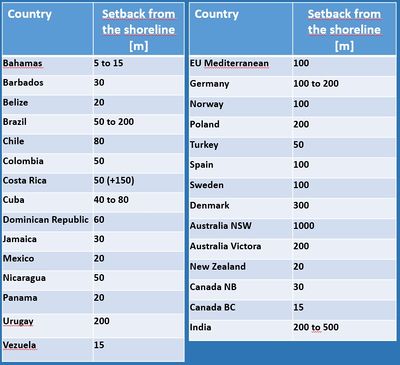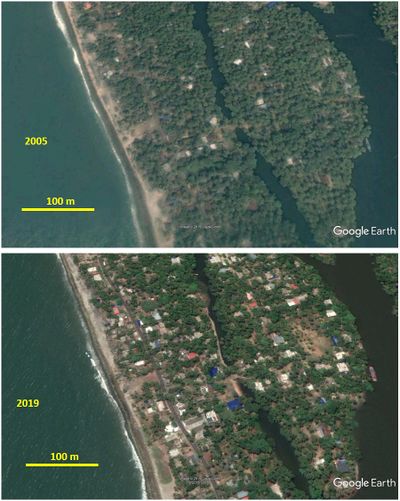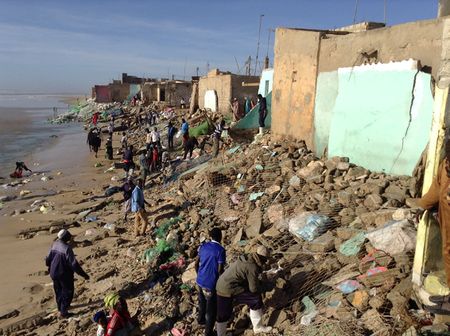Setback area
Definition of Setback area:
A strip along the coastal zone, where certain development activities are prohibited or significantly restricted, as buffer zone for storm tides, coastal erosion and adaptation to sea level rise.
This is the common definition for Setback area, other definitions can be discussed in the article
|
The setback area is delimited by setback lines, the distance from the shoreline where private hard constructions are prohibited. The shoreline is generally defined as the high-water line, but in some cases it is defined as the dunefoot or first vegetation line. Setback lines are used as coastal zone planning instrument in many countries, see Table 1. Although these setback lines are laid down in coastal regulations, they are often poorly enforced in practice. An illustration is shown in Fig. 1. Moreover, they are rarely based on a statistical analysis of extreme conditions and in that case they do not offer any guarantee of flood protection. The absence of setback lines can lead to dramatic situations, as illustrated in Fig. 2. See also the article Coastal cities and sea level rise.
Regulations equivalent to coastal setback lines exist in some other countries. In the Netherlands, for example, private building is forbidden in the coastal defense zone (including beach, seadike, first dune row), with further building restrictions in the entire coastal dune area resulting from the European NATURA directives.
In the US, there is no federal directive for coastal setback. Several states impose a setback aera that is related to estimates of local long-term coastline erosion. The width of the setback area varies from 30 to 60 times the mean annual rate of shoreline retreat, taken from a baseline which is the high water mark, the first vegetation line or the crest of the first dune row. See for example South Carolina Beachfront Permitting. Easements (governmental restrictions on land use, including acquisition rights) 'roll' inland when risk zones migrate in response to sea level rise. Transfer of Development Rights (TDR) can be used by municipalities to allow landowners with holdings in a hazard area to trade their development rights to a less sensitive area[3].
In France, the width [math]L[/math] of the coastal risk zone is defined as [math]L = 100 R + L_{max}[/math], where [math]R[/math] is the average annual retreat rate and [math]L_{max}[/math] the value of the maximum retreat following an extreme event[4].
In the UK, local planning authorities are encouraged to embed local shoreline management in their spatial plans by identifying coastal change management areas (CCMAs) where rates of shoreline change are significant over the next 100 years, taking account of climate change. Coastal change management areas should make provision for any vulnerable properties and infrastructure that may need to be relocated at a future point[5].
Due to coastal erosion and sea level rise, fixed setback areas only offer safety for a certain period. This period should not be shorter than the average lifespan of coastal development. Setback lines can then be determined on the basis of forecasts for coastal safety, taking into account trends in shoreline position and sea level rise.
References
- ↑ Simpson, M.C., Mercer Clarke, C.S.L., Clarke, J.D., Scott, D. and Clarke, A.J. 2012. Coastal Setbacks in Latin America and the Caribbean; A Study of Emerging Issues and Trends that Inform Guidelines for Coastal Planning and Development Inter-American Development Bank VPS/ESG TECHNICAL NOTE No. IDB - TN - 476
- ↑ Rochette, J. and R. Billé. 2010. Analysis of the Mediterranean ICZM Protocol: At the crossroads between the rationality of provisions and the logic of negotiations. Institute for Sustainable Development and International Relations (IDDRI). Paris. 62 pp.
- ↑ Leo, K.L., Gillies, C.L., Fitzsimons, J.A., Hale, L.Z. and Beck, M.W. 2019. Coastal habitat squeeze: A review of adaptation solutions for saltmarsh, mangrove and beach habitats. Ocean and Coastal Management 175: 180–190
- ↑ Audere, M. and Robin, M. 2021. Assessment of the vulnerability of sandy coasts to erosion (short and medium term) for coastal risk mapping (Vendee, W France). Ocean and Coastal Management 201, 105452
- ↑ Environment Agency, 2020. National Flood and Coastal Risk Management Strategy for England.
Please note that others may also have edited the contents of this article.
|


